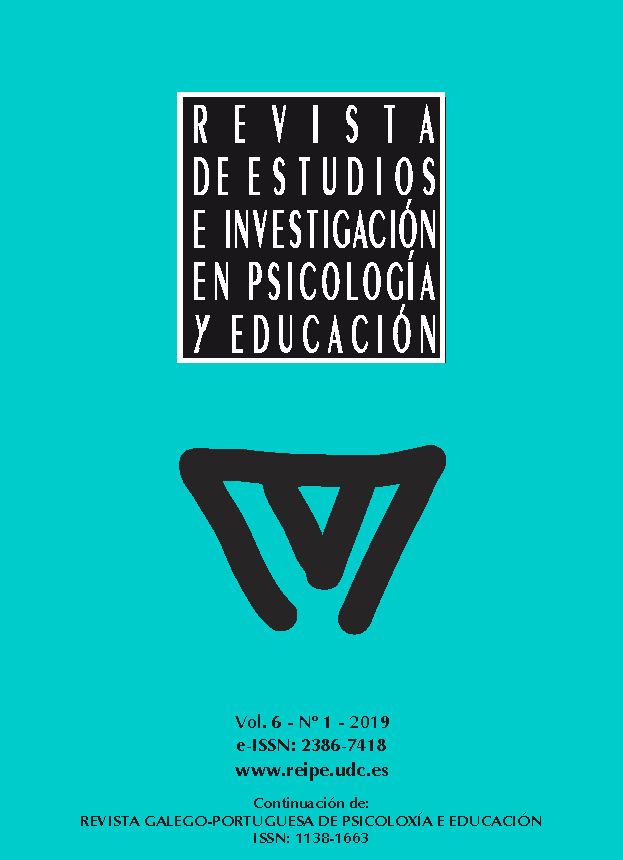Translation and adaptation to portuguese of Vanderbilt ADHD Diagnostic Teacher Rating Scale: A pilot study
Main Article Content
Abstract
TThis study integrates a broader investigation, whose purpose was to analyze the impact of Attention Deficit Hyperactivity Disorder (ADHD) within a school context, at an academic, behavioral and social level. The Vanderbilt ADHD Diagnostic Teacher Rating Scale (VADTRS) has been translated and adapted into Portuguese European, using cross-cultural translation method of back-translation and decentering, proposed by Brislin (1970, 1976). A total of 76 teachers from the 1st cycle of the island of São Miguel (Azores) filled the EVDPP for 105 (n = 105) students diagnosed (or under evaluation) for diagnosis of ADHD, aged between 6 and 11 years old, 85.7% are male gender and 14.3% are female. The statistical method used to evaluate the internal consistency of the instrument was the Chronbach's alpha. The results demonstrate the internal validity of the scale, with Chronbach's alphas being between .80 and .94 in the different dimensions, corroborating other international studies. These preliminary data suggest that EVDPP can be an extremely useful tool for the multidisciplinary teams of Portuguese schools (in particular psychologists), in the signaling, diagnosis and characterization of the main problems of the PHDA in this context.
Keywords:
Downloads
Article Details
References
American Psychiatric Association. (2014). Manual de Diagnóstico e Estatística das Perturbações Mentais (5.ª Ed.). Lisboa: Climepsi Editores.
Barkley, R. A., & Edwards, G. (2008). Entrevista diagnóstica, escalas de avaliação do comportamento e exame médico. In R. A. Barkley et al. (Ed.), Transtorno de Déficit de Atenção/Hiperatividade (3.ª ed.) (R. C. Costa, Trad.) (349-400). Porto Alegre: Artmed. (obra original publicada em 2006).
Brislin, R. W. (1970). Back-translation for cross-cultural research. Journal of cross-cultural psychology, 1(3), 185-216. https://doi.org/10.1177/135910457000100301
Brislin, R. W. (1976). Comparative research methodology: Cross-cultural studies. International Journal Of Psychology, 11(3), 215-229. https://doi.org/10.1080/00207597608247359
Brock, S. E., & Clinton, A. (2007). Diagnosis of attention-deficit/hyperactivity disorder (AD/HD) in childhood: A review of the literature. The California School Psychologist, 12(1), 73-91. https://doi.org/10.1007/BF03340933
Bylund, J. (2015). School Based Assessment of Attention-Deficit/Hyperactivity Disorder. Augusto Guzzo Revista Acadêmica, 1(15), 43-50.
Consultado em: http://fics.edu.br/index.php/augusto_guzzo/article/view/263
Conners, C. K. (1969). A teacher rating scale for use in drug studies with children. American journal of Psychiatry, 126(6), 884-888. https://doi.org/10.1176/ajp.126.6.884
Decreto-Lei nº 54/2018 de 6 de julho. Diário da República nº 129 – 1ª Série. Ministério da Educação. Lisboa.
DuPaul, G. J., & Jimerson, S. R. (2014). Assessing, understanding, and supporting students with ADHD at school: contemporary science, practice, and policy. School psychology quarterly: the official journal of the Division of School Psychology, American Psychological Association, 29(4), 379-384. https://doi.org/10.1037/spq0000104
DuPaul, G. J., Gormley, M. J., & Laracy, S. D. (2014a). School-based interventions for elementary school students with ADHD. Child and Adolescent Psychiatric Clinics of North America, 23(4), 687-697. https://doi.org/10.1016/j.chc.2014.05.003
DuPaul, G. J., Reid, R., Anastopoulos, A. D., & Power, T. J. (2014b). Assessing ADHD symptomatic behaviors and functional impairment in school settings: impact of student and teacher characteristics. School Psychology Quarterly: The Official Journal of the Division of School Psychology, American Psychological Association, 29(4), 409-421. https://doi.org/10.1037/spq0000095
Erskine, H., Ferrari, A., Nelson, P., Polanczyk, G., Flaxman, A., Vos, T., & ... Scott, J. (2013). Research review: Epidemiological modelling of attention-deficit/hyperactivity disorder and conduct disorder for the global burden of disease study 2010. Journal of Child Psychology & Psychiatry, 54(12), 1263-1274. https://doi.org/10.1111/jcpp.12144
Faraone, S. V., Asherson, P., Banaschewski, T., Biederman, J., Buitelaar, J. k., Ramos-Quiroga, J. A., ... & Franke, B. (2015). Attention-deficit/hyperactivity disorder. Nature Reviews Disease Primers, 1, 1-23. https://doi.org/10.1038/nrdp.2015.20
Hopkins, W. G. (2002). A scale of magnitudes for effect statistics. A new view of statistics. Acedido em julho 21, 2016, de: http://www.sportsci.org/resource/stats/effectmag.html
Langberg, J. M., Vaughn, A. J., Brinkman, W. B., Froehlich, T., & Epstein, J. N. (2010). Clinical utility of the Vanderbilt ADHD Rating Scale for ruling out comorbid learning disorders. Pediatrics, 126(5), e1033-e1038. https://doi.org/10.1542/peds.2010-1267
Marôco, J. (2014). Análise estatística com o SPSS Statistics (6.ª Edição). Pero Pinheiro: ReportNumber.
Oliveira, L., Pereira, M., Medeiros, M., & Serrano, A. (2016). PHDA: O que há de novo no DSM-5? Revista Portuguesa de Pedagogia, 49(2), 75-94. https://doi.org/10.14195/1647-8614_49-2_4
Rodrigues, A. N. (2007). Escalas revistas de Conners – formas reduzidas para pais e professores. In M. R. Simões, C. Machado, M. M. Gonçalves, & L. S. Almeida (Coord.), Avaliação psicológica: Instrumentos validados para a população portuguesa (Vol. III) (pp.203-227). Coimbra: Edições Quarteto.
Salmon, G., & Kirby, A. (2009). The role of teachers in the assessment of children suspected of having AD/HD. British Journal of Special Education, 36(3), 147-154. https://doi.org/10.1111/j.1467-8578.2009.00439.x
Shillingford-Butler, M. A., & Theodore, L. (2013). Students diagnosed with attention deficit hyperactivity disorder: Collaborative strategies for school counselors. Professional School Counseling, 16(4), 235-245. https://doi.org/10.1177/2156759X12016002S05
Schulte-Körne, G. (2016). Mental Health Problems in a School Setting in Children and Adolescents. Deutsches Ärzteblatt International, 113(11), 183-190. https://doi.org/10.3238/arztebl.2016.0183
Weyandt, L. L., & DuPaul, G. J. (2013). Assessment of ADHD. In College Students with ADHD (37-60). Springer New York. https://doi.org/10.1007/978-1-4614-5345-1_4
Willcutt, E. G. (2012). The prevalence of DSM-IV attention-deficit/hyperactivity disorder: a meta-analytic review. Neurotherapeutics, 9(3), 490-499. https://doi.org/10.1007/s13311-012-0135-8
Wolraich, M. L., Bard, D. E., Neas, B., Doffing, M., & Beck, L. (2013). The psychometric properties of the Vanderbilt attention-deficit hyperactivity disorder diagnostic teacher rating scale in a community population. Journal of Developmental & Behavioral Pediatrics, 34(2), 83-93. https://doi.org/10.1097/DBP.0b013e31827d55c3
Wolraich, M. L., Lambert, E. W., Baumgaertel, A., Garcia-Tornel, S., Feurer, I. D., Bickman, L., & Doffing, M. A. (2003a). Teachers' screening for attention deficit/hyperactivity disorder: Comparing multinational samples on teacher ratings of ADHD. Journal of Abnormal Child Psychology, 31(4), 445-455. https://doi.org/10.1023/A:1023847719796
Wolraich, M. L., Lambert, E. W., Doffing, M. A., Bickman, L., Simmons, T., & Worley, K. (2003b). Psychometric properties of the Vanderbilt ADHD diagnostic parent rating scale in a referred population. Journal of Pediatric Psychology, 28(8), 559-568. https://doi.org/10.1093/jpepsy/jsg046
Wolraich, M. L., Feurer, I., Hannah, J., Baumgaertel, A., & Pinnock, T. (1998). Obtaining systematic teacher reports of disruptive behavior disorders utilizing DSM-IV. Journal of Abnormal Child Psychology, 26(2), 141-152. https://doi.org/10.1023/A:1022673906401



